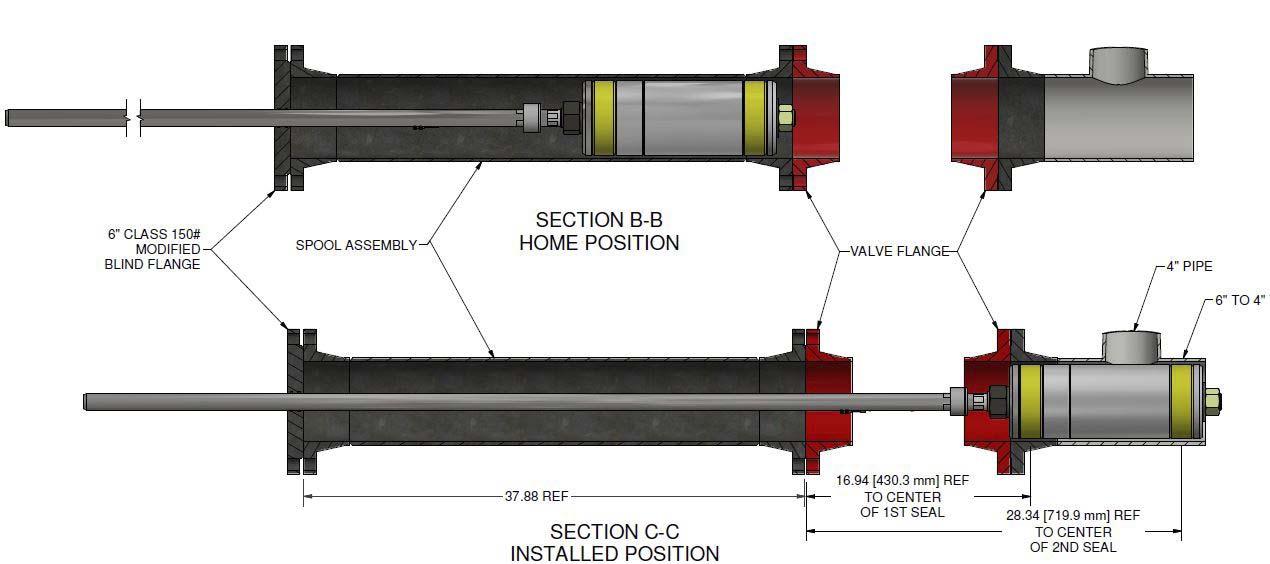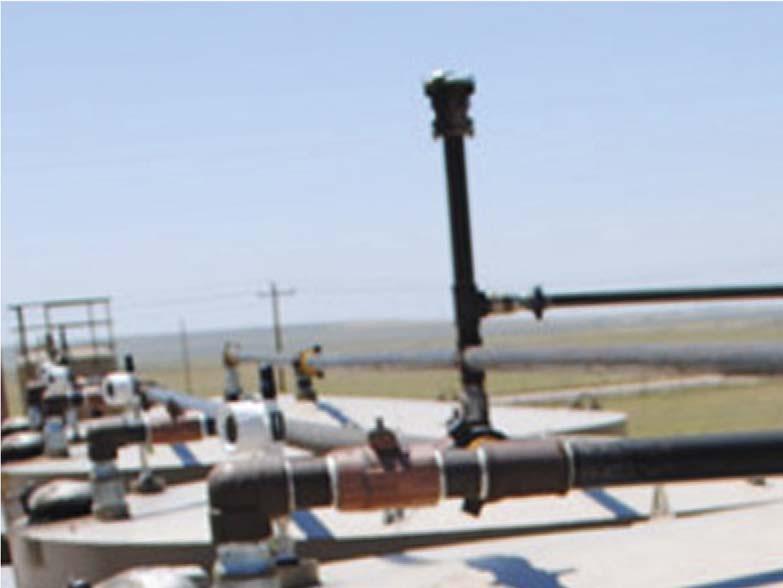
7 minute read
Development down under




Hans Sturm, Curtiss-Wright EST Group, USA, presents a novel isolation approach designed to bring speed, safety, and security to pipeline valve replacement.
When a pipeline valve needs to be replaced, safety and speed are key considerations. However, when the pipeline cannot be fully drained of its contents and depressurised, these considerations take on a whole new sense of urgency.
This was the case for an oil and gas operator working off the coast of Australia. The operator needed to replace a blowdown valve on a spool filled with hydrocarbons on one of its off shore platforms. They wanted to avoid the conventional process that requires flushing, purging, and then drying the entire spool volume prior to performing the changeout, all of which would add a great deal of time and money to the project.
Further complicating the process, the valve changeout had to be done while ensuring that the spool was completely isolated at all times. There could be no oxygen ingress to the line and no release of hydrocarbons into the atmosphere.



Field-proven solution
Curtiss-Wright EST Group proposed a solution that previously proved successful for the operator in other ‘tie-in’ applications, such as installing new flanges




into existing pipework: the double block and bleed (DBB) test and isolation plug. The DBB is widely used to isolate and monitor potentially explosive vapours from upstream gases or hydrocarbon fluids in a vessel or pipeline during modifications or repairs requiring hot work.
The plug’s dual-cavity port creates a completely air-free, positive pressure barrier between its seals, allowing isolation for welding activities and hydrotesting of new weld connections to be performed with the same isolation tool. Traditionally, this plug is used to increase the safety for welding activities and gives the operator the ability to hydrotest the new weld between the seals with less than one gallon (3.785 l) of water. This reduces fill times, waste water, and treatment expenses while facilitating testing in remote areas of the facility. The dual port system also allows water to be circulated between the seals for improved cooling during pre- and post-weld procedures.
The standard plug’s seal is pressure rated to 2250 psig (155 barg), with upstream pressure rated to 10 psig (0.7 barg). Higher pressure ratings can be achieved with special plug designs.
The plug’s lightweight, predominantly aluminium construction During deployment of the plug, the team had to develop a way makes it significantly lighter than other plugs. An 8 in. schedule to not only extend the plug to its setting location and safely bring it 80 plug, for example, weighs just 36 lbs (16.3 kg) while similarly back, but also maintain pressure boundaries between the hydraulic sized plugs typically weigh in excess of 100 lbs (45.4 kg). This allows hose assembly, connections, fittings, and gauges inside the launching operators to avoid the use of cranes or other heavy lift ing devices, spool assembly and the atmosphere. The solution was to route which are oft en in high demand during plant turnarounds. the hose assembly around the push rod in a spiral. As the plug was moved into position, the assembly extended like an unravelling A novel installation approach spring to ensure service to the test plug was maintained while the While the operator was confident that a standard DBB would plug was extended. Once the seals were compressed, the hydraulics eff ectively isolate the line during the valve changeout, the installation were locked and monitored and remained in the system – along with process presented some challenges. The valve would have to be the plug and the rod. opened to allow the plug to pass through to its set point, which would To ensure that the plug was fully engaged with the pipe during expose the system to oxygen. the entire process, the team had to continuously monitor the
Working in collaboration with its Australian distributor PipeServ, pressure at the plug. The plug was positioned in the line such that EST Group developed a customised plug and installation strategy, the two seals straddled a 4 in. auxiliary pipe running off the main line. with the ultimate goal of making plug installation as eff icient, The team pressurised the auxiliary line and monitored it for any drops seamless, and risk-free as possible, without adding to the operator’s in pressure, which would indicate that one or both seals was leaking. maintenance budget. The solution included a custom launching With the plug secure, the nitrogen pressure was released, and spool assembly that housed a specially designed, hydraulically the launching spool assembly and failed blowdown valve were safely actuated DBB test and isolation plug (Figure 1). removed. A new valve was securely installed. The launching spool
The launching spool and DBB were designed to safely isolate the assembly was reinstalled to the new valve flange and the process was valve during changeout through the following installation process. reversed to safely remove the special DBB plug. The entire process First, the spool assembly was attached to the valve flange. Then, enabled safe replacement of the blowdown valve while maintaining the DBB was inserted into the spool assembly with a lanyard and a nitrogen-rich environment to ensure no hydrocarbons escaped and the chamber was sealed with a flange. Nitrogen gas was introduced no oxygen entered the system. between the flange and the DBB plug to displace all oxygen from the system. Success through collaboration
With the launching spool closed off and no oxygen present, the The company needed to operate under a tight timeline to ensure valve was then opened to allow passage of the plug. The DBB was successful execution of this project. Working closely with the pushed out of the launching spool assembly, through the valve and operator’s team to ensure it met all of their specifications, they able extended into the line with a long push rod to isolate the valve flange to develop the hydraulically actuated DBB plug and successfully while the upstream chamber was pressurised with nitrogen. The deliver it within the short window of opportunity. assembly was designed to ensure that the DBB would be positioned The plug was flown to the off shore platform by helicopter in the line precisely where it needed to be with a predetermined where the operator’s maintenance crew performed the installation measurement verification marking on the lanyard. successfully. In addition to the operator’s crew, a dedicated PipeServ
The position of the plug in the line made the conventional technician was on site during the process to ensure the valve actuation process of mechanically activating the plug by manually change-out went smoothly. The crew was able to perform the valve torqueing the nuts on the shaft of the plug impossible. The system replacement in about one day, realizing a significant cost savings in was under pressure and closed off from the atmosphere. This time and labour for the operator, over the 4-day schedule originally necessitated the special hydraulically actuated plug, which included planned. a hydraulic piston cylinder internal to the DBB. The cylinder was Remote technical support, and detailed installation instructions activated by energising a hydraulic hose that fed to the plug. As the provided with the plug were contributing factors to the success of cylinder moved, it compressed the seal material forming a leak-tight the project as well. Rather than flying an application expert to the seal on the two locations on the pipe wall. site to oversee the process, which would have added significant cost and additional days to the job, the operator’s maintenance crew were able to perform the repair easily and eff iciently by following the detailed installation steps. The custom solution not only delivered significantly lower repair costs vs a traditional valve replacement procedure, but the operator was able to keep their crew safe and the integrity of the pipeline and other equipment intact as well. The operator plans to document the success of this project to standardise similar Figure 1. The DBB housed in the spool assembly prior to deployment (top), and aft er it has been deployed through procedures for other valve the valve and into its setting position by the push rod (bottom). changing applications.











